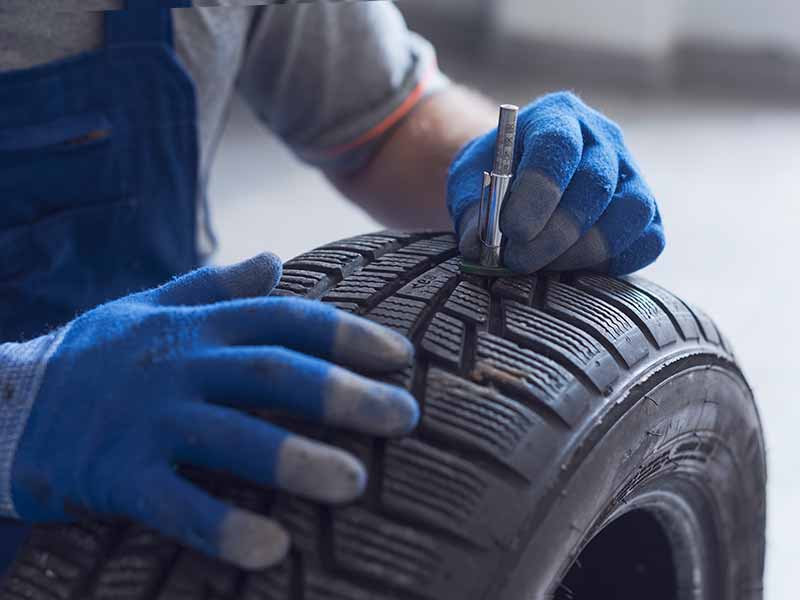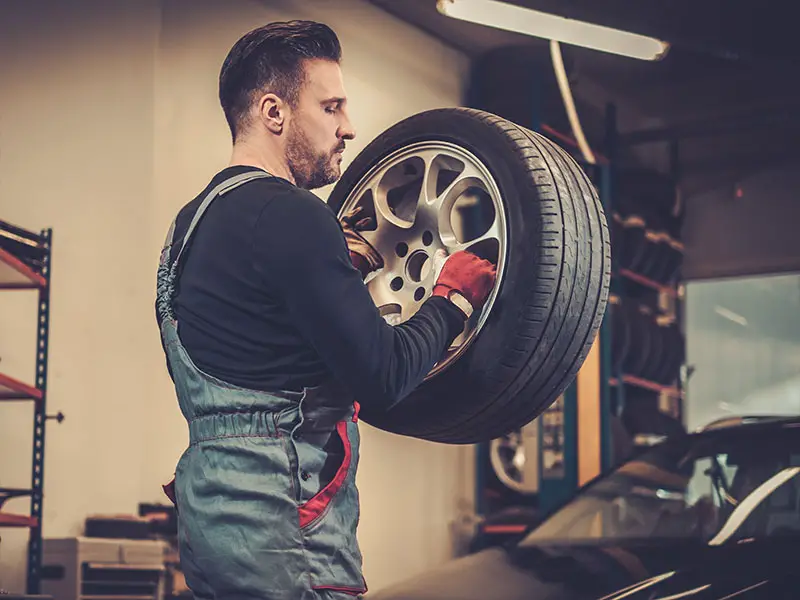Tire rotation is important to ensure all four tires are evenly worn. New tires aren’t cheap so getting the most out of them certainly makes sense. Tires are also extremely important for safety.
But no one wants to wait around at their local mechanic to have a service performed unless it really needs to be done.
Let’s go over how often you should have your tires rotated as well as some important details you should know about tire rotation to help you save money.
How Often Should You Rotate Your Tires?
Tires should be rotated every 5,000 miles or every 6 months. This is a general rule of thumb.
If you want to maintain your tire manufacturer’s warranty you should follow the guidance required by the tire manufacturer.
Manufacturer’s guidance on tire rotation will vary but 5,000 mile regular tire rotations should meet or exceed most tire manufacturer warranty requirements.
Is It OK To Rotate Tires Every 10,000 Miles?
Rotating your tires every 10,000 miles will extend their life compared to not rotating your tires at all, but they will likely not last as long as the tire manufacturer warranty claims.
Many car owner’s will have their tires rotated during their regular oil change service. This is a great idea and a good way to ensure you’re regularly rotating your tires.
The only problem with this method is that synthetic oils have lengthened the time between oil change intervals to beyond that required to maintain your tire manufacturer warranty. If this is the case for you, may need to get your tires rotated in-between oil changes.
Different tire brands will have various requirements for maintaining the tire warranty. For instance, Yokohama requires tires be rotated every 5,000 miles.
Michelin requires tires be rotated the lesser of 6,000 to 8,000 miles or what the vehicle manufacturers recommend. In this scenario, a Tesla owner would need to have their Michelin tires rotated regularly before reaching 6,250 miles or every 2/32 of tread wear according the Tesla’s recommendations.
You should always refer to both the tire manufacturer recommendations as well as your vehicle owner’s manual for best tire maintenance practices.
Do You Really Need To Rotate Your Tires?
It’s not necessarily unsafe to not rotate your tires, however it will cause your tires to wear out more quickly than if you maintain a proper rotation schedule.
Tires wear unevenly without regular tire rotations due to suspension geometries that are designed to improve traction and stability at the expense of even tire wear.
Front tires typically have what is called toe-in and rear tires typically have negative camber. These suspension settings improve handling but the tires don’t sit flat on the road surface.
Toe-in is where the front tires point inward toward the centerline of the car or truck. Similar to if you are standing with your big toes closer to each other than normal.
Toe-in helps prevent oversteer which is when the rear end of the car begins to slide around more easily when turning.
Negative camber is where the tops of the rear tires point inward toward the centerline of the vehicle. This helps greatly with cornering grip.
How Much Longer Will Tires Last If Rotated?
Rotating your tires regularly can easily increase tire life by 20%, 30%, 40% or more. This can vary significantly between different types of vehicles.
There are many factors that affect how long tires will last. Tire rotation is obviously very important, but driving style will also make a significant difference.
What Happens If You Never Rotate Your Tires?
Not rotating your tires means that they will ride with more pressure on certain portions of the tire tread and less on others for the life of the tire. You will end up with tires that are completely worn on one side of the tread and nearly no wear at all on the other.
Front tires wear two to three times more quickly on a front wheel drive car than rear tires. Rear tires on rear wheel drive cars and trucks will wear more quickly.
If you don’t perform regular tire rotation front to rear, one pair of tires will wear out significantly quicker than the other without properly using all of the available tread depth across the tire.
This means that you will essentially be wasting the tire tread that gets almost no wear. With more aggressive suspension geometries, like those on sports cars, you can easily loose half of the life your tires due to these poor wear patterns.
Can You Rotate Your Tires Too Often?
It’s not bad to rotate your tires more often than recommended as long as you are ensuring that the amount of mileage between rotations is even. If the rotation intervals are inconsistent the evening out of the wear may not be as effective.
Since the point of tire rotation is to move the tires to various positions on your car or truck to allow them to wear evenly, or as evenly as possible depending on the suspension geometries unique to your vehicle, ensuring that your tires get equal exposure to the unique forces at each corner of your car or truck is important.
If you have an opportunity to rotate your tires sooner than normal because you’re at another maintenance service appointment doesn’t mean you should go ahead and have them rotated.

How Long Should Tires Last?
Most passenger vehicle tires last around 40,000 miles under normal use. The amount varies some from tire to tire but each manufacturer lists a warrantied number of miles they guarantee as long as you meet their requirements.
The amount of time that tires should last depends on the hardness of the rubber compound, tread design, driving style, vehicle type, and how well the tires are cared for and rotated properly.
What Is The Proper Tire Rotation Pattern?
There are several tire rotation patterns that are used, but the best one for most types of cars and trucks is the X-pattern.
The forward cross works well for front wheel drive vehicles. The rearward cross works well for rear wheel drive vehicles and all wheel drive cars and trucks. The X-pattern can be used on all three unless there is a unique situation that prevents its use.
The forward cross and the rearward cross do a slightly better job of ensuring that your tires are evenly worn, but the X-pattern comes very close and works for the vast majority of cars and trucks.
Situations were having your tires rotated according to one of these patterns isn’t recommended is when you have directional tires or staggered wheel sizes. These situations each have unique rotation pattern requirements.
You can learn more in our detailed article on tire rotation patterns.
X-Pattern Tire Rotation Diagram
Final Thoughts
How often should you rotate your tires largely depends on the requirements by your tire manufacturer to maintain the tire mileage warranty. Usually tire rotations every 5,000 miles will meet or exceed those requirements.
Some vehicles will have unique tire rotation requirements so beside to check your owner’s manual for any suggestions that may affect how often you should have your tires rotated.
Regular rotations will help you save money by getting the most use out of your tires, and ensuring you can cash in on the tire warranty if they don’t meet the guaranteed mileage.
Resources
Below are some links you may find helpful when learning about tires





